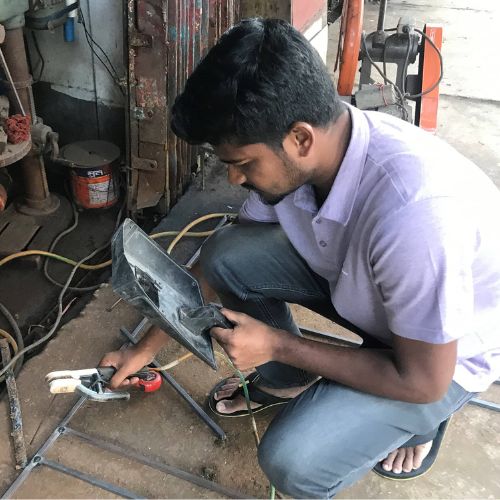It is technically possible to tig weld galvanized steel and you can weld any galvanized steel with tig welder. But the problem is you will face a myriad of problems and challenges doing so. Also experts recommend not to tig weld galvanized steel because of its inefficiency, health issues and fragile weld.
In this post you will learn
- How to tig weld galvanized steel
- What challenges you will face welding galvanized steel with tig
- Solutions to the problems
- Welder settings and some special tips
Lets start the discussion-

Challenges In Tig Welding Galvanized Steel
You may face some challenges while welding galvanized steel with a tig welder. Most of them are common and are face in welding galvanized steel by any mean.
Health issues
First issue you may face is health issue. You already know that galvanized steel is made with a layer of zinc coating over the metal. While tig welding, we use a tig electrode that is continuously heated to melt and join metals.
As zinc has a low melting point than the base metal and tig rod, thus heat from the tig welder melt burn the zinc and make huge amount of toxic fumes. If you inhale the fume you may suffer from metal fever. In a word tig welding galvanized steel could be dangerous for your health.
Low Quality Weld
Because of zinc on the galvanized steel, the generated heat would react with zinc and the tig electrode first. As a result, electrode would melt down but the base metal still remain unheated.
That is the reason the joint will not be that strong creating low quality and fragile weld. With a slight load the joint may be broken.
Porosity
Tig welding over galvanized steel would produce more porosity and inclusion than any other welding type over the galvanized steel. Porosity can scatter here and there and can create spatter ball inside the tig gun.
This is a serious issue and it can damage the tig welder and tig gun causing huge financial loss as you already know that how much a tig welder cost.
Solutions
Where there is problems, there are also solutions.
To deal with health issue, use respiratory mask and welding helmet. You may also wear PPE dress to protect your body from getting burn while welding. You should wear gloves as well. Set up a fume extractor in the weld area and turn a fan on to drive the fumes away from weld area.
Also choose a well ventilated place to do tig welding over galvanized steel. Don’t try to tig weld galvanized steel outdoor.
Now come to the solution to deal with weld quality. To increase weld quality first grind off at least 1-4 inch the zinc coating from galvanized steel and then apply heat on the base metal. You should use electrode suitable for galvanized steel and tig gun that is compatible with greater heat management feature.
Also, weld quality depends on how efficiently and perfectly you hold the gun and travel it onto the weldable metal. If you have some experience over welding with tig welder then it would be best for quality weld on galvanized steel.
To lower the porosity you should use higher power tig welder at least bellow 200 Ampere. The heat must be at applied at a random basis meaning the welder must have 60% or more duty cycle @ 108. You should go for welding at reduced travel speed over the base metal otherwise there would be risk of burn through.
Check out few tig welders that meet the requirements.
Yeswelder Tig 250p Welder

Primeweld Tig 225x Welder

Step-by-step Guide to TIG Welding Galvanized Steel
You’ll need
- A TIG welder
- Tungsten electrode
- Filler rod suitable for galvanized steel
- A grinder
- And safety gear including welding helmet, gloves, and respirator mask.
- Step-1: Preparation of the material:
Start by using a grinder to remove the galvanized coating around the area where you plan to weld. By doing so, you may reduce the risk of inhaling harmful fumes that in turn results in metal fever.
- Step-2: Settings for the TIG welder:
Galvanized steel requires lower heat settings to prevent burn-through. Start with a lower amperage and adjust as needed.
- Step-3: Technique:
Begin welding at one end of the joint. Make sure to feed the filler rod into the weld pool consistently and maintain a steady hand throughout. Run the tig gun in one direction at a reduced speed to avoid burn through. If you run from right to left then continue to do so until finish.
- Step-4: Post-welding processes:
After welding, clean the welded area thoroughly and check the weld for any inconsistencies or signs of burn-through. Also to reduce porosity use anti-spatter spray. And lastly let the weld cool and grind to make smooth.
Tips and Tricks for Effective TIG Welding of Galvanized Steel
Welding in a well-ventilated area or using a fume extraction system is essential when working with galvanized steel. Additionally, a steady hand is crucial for controlling the heat input and avoiding burn-through. If you encounter issues like porosity, consider adjusting your technique or equipment settings.
Remember, TIG welding galvanized steel requires patience and practice. Be sure to follow the safety guidelines, and don’t rush the process. Learn TIG welding well and make strong welds on galvanized steel. Take your time.
Conclusion
TIG welding galvanized steel can be a challenge, but with the right techniques and safety measures, it’s an invaluable skill for many industries. By preparing the material correctly, controlling heat input, and taking safety precautions, you can produce high-quality, durable welds.
References
